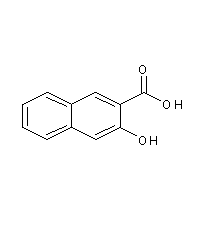3-Hydroxy-2-naphthoic acid

Structural formula
| Business number | 0252 |
|---|---|
| Molecular formula | C11H8O3 |
| Molecular weight | 188.18 |
| label |
2-Naphthol-3-carboxylic acid, 2-Hydroxy-3-naphthoic acid, β-Hydroxynaphthoic acid, 2-Naphthol-3-carboxylic acid, β-Hydroxynaphthoic acid |
Numbering system
CAS number:92-70-6
MDL number:MFCD00004103
EINECS number:202-180-8
RTECS number:QL1755000
BRN number:744100
PubChem number:24895525
Physical property data
1. Properties: light yellow crystal.
2. Density (g/mL, 25/4℃): 1.034
3. Relative vapor density (g/mL, air=1): Undetermined
4. Melting point (ºC): 222~223
5. Crystal phase standard combustion heat (enthalpy) (kJ·mol-1): -4924.1
6. Crystal phase standard claims heat (enthalpy) (kJ·mol-1): -547.8
7. Refractive index: Undetermined
8. Flash point (ºC): >150
9. Specific rotation (º): Undetermined
10. Autoignition point or ignition temperature (ºC): Undetermined
11. Vapor pressure (kPa, 25ºC): Undetermined
12. Saturated vapor pressure (kPa, 60ºC): Undetermined
13. Heat of combustion (KJ/mol): Undetermined
14. Critical temperature (ºC): Undetermined
15. Critical pressure (KPa): Undetermined
16. The logarithmic value of the oil-water (octanol/water) partition coefficient: Undetermined
17. The upper explosion limit (%, V/V): Undetermined
18. The lower explosion limit (%, V/V): Undetermined
19. Solubility: Easily soluble in ethanol and ether, soluble in benzene, chloroform and alkali solutions, slightly soluble in hot water, almost insoluble in cold water.
Toxicological data
Acute toxicity:
Oral LD50: 783 mg/kg (guinea pig)
800 mg/kg(mus)
832 mg/kg(rat )
Main irritant effects:
On skin: Irritation to skin and mucous membranes.
On the eyes: effects of irritation.
Sensitization: No known sensitizing effects.
Ecological data
General Notes
Water Hazard Level 1 (German Regulation) (PassedList for self-assessment) This substance is slightly hazardous to water.
Do not allow undiluted or large quantities of product to come into contact with groundwater, waterways or sewage systems.
Do not discharge materials into the surrounding environment without government permission.
Molecular structure data
1. Hydrophobic parameter calculation reference value (XlogP): 2.9
2. Number of hydrogen bond donors: 2
3. Number of hydrogen bond acceptors: 3
4. Number of rotatable chemical bonds: 1
5. Number of tautomers: 4
6. Topological molecular polar surface area (TPSA): 57.5
p>
7. Number of heavy atoms: 14
8. Surface charge: 0
9. Complexity: 227
10. Number of isotope atoms : 0
11. Determine the number of atomic stereocenters: 0
12. Uncertain number of atomic stereocenters: 0
13. Determine the chemical bond configuration Number of centers: 0
14. Number of uncertain chemical bond stereocenters: 0
15. Number of covalent bond units: 1
Compute chemical data
1. Reference value for hydrophobic parameter calculation (XlogP): 2.9
2. Number of hydrogen bond donors: 2
3. Number of hydrogen bond acceptors: 3
4. Number of rotatable chemical bonds: 1
5. Number of tautomers: 5
6. Topological molecule polar surface area 57.5
7. Number of heavy atoms: 14
8. Surface charge: 0
9. Complexity: 227
10. Number of isotope atoms: 0
11. Determine the number of atomic stereocenters: 0
12. Uncertain number of atomic stereocenters: 0
13. Determine the number of chemical bond stereocenters: 0
14. Number of uncertain chemical bond stereocenters: 0
15. Number of covalent bond units: 1
Properties and stability
Moderately toxic, irritating to skin and mucous membranes. Rats were injected subcutaneously with LD50: 376 mg/kg. The reaction equipment should be sealed, and the carboxylation reactor must meet pressure resistance standards. Operators should wear protective equipment such as protective masks and maintain good ventilation in the workshop.
Storage method
This product should be sealed and stored away from light.
Synthesis method
After β-naphthol is salted with sodium hydroxide, it is heated and dehydrated under reduced pressure. The anhydrous β-naphthol salt is carboxylated with carbon dioxide to produce 2,3 acid disodium salt, which is then acidified with sulfuric acid to obtain the finished product. .
Purpose
Dye intermediates. Used to synthesize naphthol AS and other various naphthols, such as naphthol AS-BO, AS-RL, AS-E, AS-D, AS-VL, AS-BS, AS-OL, etc. It can also be used to produce light-fast bright red BBC, light-fast bright red BBN, rubber bright red LG, pigment bright red 6B, and Lisol red BK. Also used as pharmaceutical intermediates.
extended-reading:https://www.bdmaee.net/triethylenediamine-cas280-57-9-14-diazabicyclo2-2-2octane/extended-reading:https://www.newtopchem.com/archives/40394extended-reading:https://www.newtopchem.com/archives/category/products/page/138extended-reading:https://www.morpholine.org/category/morpholine/page/5398/extended-reading:https://www.bdmaee.net/n-ethylmorpholine/extended-reading:https://www.newtopchem.com/archives/category/products/page/35extended-reading:https://www.bdmaee.net/butylhydroxyoxo-stannane/extended-reading:https://www.bdmaee.net/jeffcat-zf-20/extended-reading:https://www.bdmaee.net/u-cat-3513n-catalyst-cas135083-58-9-sanyo-japan/extended-reading:https://www.bdmaee.net/lupragen-n500-catalyst-basf/


